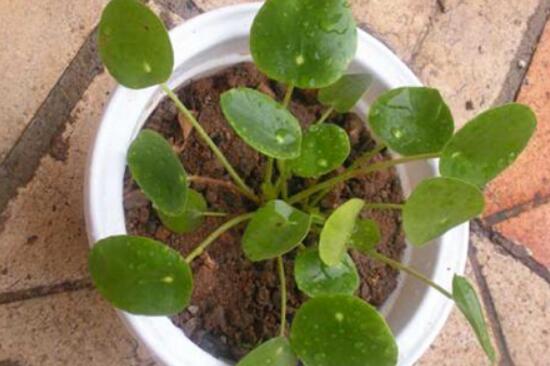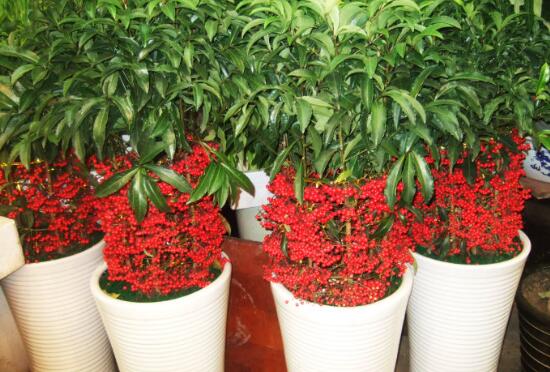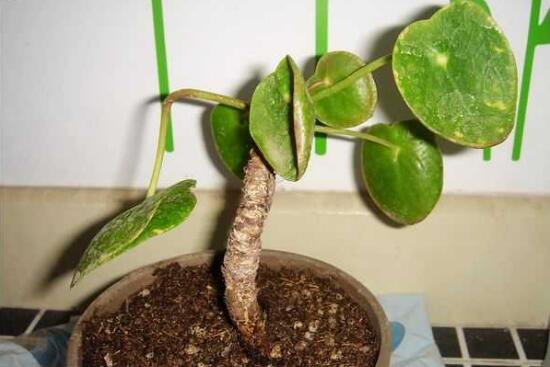What if the leaves of mirror grass turn yellow, supplement light / appropriate shade / spray with diseases and insect pests
Mirror grass this kind of plant, flower friends should be no stranger, its leaves are large and round, very much like the ancient mirror, its potted at home has an excellent ornamental. Such plants are naturally raised at home by many people, but in the process of breeding, many flower friends' plants will appear yellow leaves, affecting ornamental. So, what if the leaves of the mirror grass turn yellow? Today, the editor is here to solve this problem for everyone.
First, what if the leaves of mirror grass turn yellow?

If the leaves of mirror grass turn yellow caused by sudden changes in the environment, you can create the most suitable growth environment for it; if it is caused by lack of light, add light; that is, too much loose soil, there are rotten roots, but also need to cut the roots and change the pot soil to plant again; if the temperature is too low, adjust the temperature; if you encounter diseases and insect pests, you should spray and control them in time.
Second, the causes of the yellowing of the leaves of mirror grass and its solutions.
1. Environmental mutation
If you want to talk about the reason why the leaves of mirror grass turn yellow, if it is a newly bought potted plant, we should consider environmental factors. Nowadays, most of the mirror grass potted plants of flower friends are bought online, which can easily lead to regional cross-service, the environment changes too much, mirror grass can not adapt for a while and the leaves are yellow.
Solution: it is very simple, if the newly bought mirror grass appears leaf yellow, according to its growth habits, we provide it with the most suitable growth environment, after a period of time, the plant will return to health.
2. Too little light
Although mirror grass is shade-tolerant, as a foliage plant, it also has a demand for light. Once it is changed in the dark for a long time, its leaves will turn yellow because of the lack of photosynthetic nutrients.
Solution: very simple, add light, but to avoid direct sunlight, especially in summer, be sure to shade, so as not to burn the leaves, the best way is to move the pot to a place with plenty of astigmatism.
3. Overwatering
Mirror grass likes the humid environment, in the breeding process, we should water frequently. However, although mirror grass likes water, it can keep the basin soil dry and must not pour too much water, otherwise it will cause stagnant water in the basin and lead to root rot, and its leaves will turn yellow because they cannot absorb nutrients.
Solution: loosen the soil and move the pot to a ventilated sunny place to let the water evaporate quickly; if it is not found in time, the roots rot, we also need to take off the pot and cut the roots, and then change the pot soil to replant.
4. The temperature is too low
Mirror grass likes a warm environment and is more hardy, but the overwintering temperature should be kept at 7 ℃, otherwise the leaves of mirror grass will turn yellow, the leaves of mirror grass will curl, the leaves of mirror grass will fall off, and even frostbite will occur.
Solution: after the advent of winter, we should move the mirror grass to indoor maintenance, it is best to control the room temperature above 7 ℃.
5. Diseases and insect pests
If the above points can be ruled out, then the yellowing of mirror grass leaves may be caused by diseases and insect pests. Although mirror grass is not easy to grow insects to get sick, but in the case of improper maintenance, the environment is not ventilated, it will also be affected by diseases and pests and disease infection. The appearance of these diseases and insect pests may lead to the yellowing of grass leaves.
Solution: very simple, identify specific diseases and insect pests, and then control for spraying, as for what medicine to spray, you can refer to the pest control of mirror grass.
Generally speaking, the breeding method of mirror grass is not difficult, but because many flower friends are novices, it is inevitable that there will be symptoms of leaf yellow. However, after reading the full text, I believe you have a clear mind, the leaf yellow problem can be solved in accordance with the above method. With regard to the yellowing of mirror grass leaves, the editor has introduced this, hoping to give you some help.
How to raise mirror grass, breeding methods and matters needing attention / like astigmatism exposure
Mirror grass, named because its leaves look like the mirror of ancient fairies, is a beautiful foliage plant and is deeply loved by flower friends. In life, many people want to keep a pot of mirror grass at home, so how to raise it? The following are the cultivation methods and matters needing attention of potted mirror grass carefully arranged by the editor, which are very comprehensive and should not be missed.
First, how to raise mirror grass and understand its habits
Mirror grass likes a warm, humid environment, it is cold-resistant, like shade, avoid strong light, so how to raise mirror grass? When keeping it indoors, it should be placed in a place with sufficient astigmatism and watered frequently to keep the basin soil slightly wet. As for cultivated soil, it is best to choose peat soil that is moist and well drained.
II. Culture methods and matters needing attention of mirror grass
1. Soil
How to raise mirror grass indoors, the soil should be re-selected first. Nowadays, the mirror grass of flower friends is basically bought online, and there are existing potted plants. normal maintenance can ensure plant growth, but the soil is very cheap. if you want mirror grass to grow well, you'd better choose the soil again.
Soil selection: according to the growth habits of mirror grass, it likes loose and fertile soil with good drainage and air permeability. In this regard, the editor recommends that we use 3 parts of rotten leaf soil, 3 parts of garden soil, 2 parts of river sand or furnace ash, and 1 part of rotten organic fertilizer. It is best to pad tiles at the bottom of the flowerpot to facilitate drainage.
2. Lighting
Mirror grass is a foliage plant, so there is a great demand for light, but it avoids strong light, so when breeding indoors, it should be placed in a place where there is enough astigmatism but can avoid strong light.
Note: mirror grass requires high light, not too strong, not too concealed; once the light is too strong, its leaves are easy to burn; once too shaded, the leaves are easy to become thinner, petioles become longer and cause leaves to droop.
3. Temperature
How to raise mirror grass, the appropriate adjustment of temperature is also very necessary. It is understood that mirror grass likes a warm environment, and the most suitable growth temperature is 15-20 ℃. If it wants to grow well, it is best to maintain this growth problem.
Note: although the mirror grass is more hardy, the overwintering temperature should be kept at 7 ℃, otherwise the leaves of the mirror grass will turn yellow, the leaves of the mirror grass will curl, the leaves of the mirror grass will fall off, and even be frostbitten; at the same time, the mirror grass is also afraid of high temperature, when the temperature is higher than 30 ℃, the plant growth will stagnate and the leaves will fall off easily.
4. Watering
Water is the source of life, and watering is an essential link in the breeding methods and matters needing attention of mirror grass. Because mirror grass likes a humid environment, it is necessary to water more at ordinary times to keep the basin soil moist. The watering times should be controlled when the winter temperature is lower than 12 ℃, otherwise it is perishable and not conducive to overwintering.
Note: mirror grass requires high moisture, if not watered, it is easy to appear mirror grass leaves yellow sagging, serious leaves will appear wrinkles and even death; at the same time, mirror grass avoid stagnant water, watering can not be too much, otherwise it will cause leaf discoloration, and even root rot, death.
5. Fertilization
After watering, let's talk about fertilization, it is also very important in the breeding method of mirror grass. Spring and summer is the growing period of mirror grass, at this time, fertilization should be once a semimonthly dilute liquid fertilizer, and should be often irrigated with 0.1% 0.5% potassium dihydrogen phosphate solution or foliar spray.
Note: because the stems and leaves of mirror grass are fleshy, it needs fertilizer, but it is not resistant to thick fertilizer and large fertilizer. When fertilizing it, it should be carried out a few times, and it is most suitable to be irrigated with thin fertilizer. Once fertilizing too much, it will cause excessive growth of leaves, lodging of plants, and in serious cases, rotting roots and even death.
6. Diseases and insect pests
In the process of the growth of mirror grass, due to a variety of reasons, the plant will inevitably cause disease and insect damage. According to the inquiry, the main diseases and insect pests are: shell insects, red spiders, leaf spot, anthrax and so on, they all endanger the health of plants. So once found, we should immediately spray control, as for what medicine should be sprayed, you can refer to the pest control of mirror grass.
What is the culture method of mirror grass?
Mirror grass is very suitable for indoor planting because of its beautiful leaf shape, easy breeding, cold resistance and shade resistance, and it is also a good material for decorating bonsai. Next, I will tell you what is mirror grass, as well as mirror grass breeding methods.
What is mirror grass?
Mirror grass, also known as Cuiping grass, is a perennial succulent herb of Urticaceae and cold water flower. Although mirror grass is not a mirror, it has thick, nearly circular fleshy leaves with a shield-shaped petiole, much like the mirror of ancient fairies, so people affectionately call it mirror grass. The leaf of mirror grass is dark green and shiny, and there is a golden dot in the upper middle of the leaf, so it is also called "a little gold". There are radiating veins from the center to all sides, and some people call it "golden thread grass". The emerald-green leaves are like a round screen, so people in Yunnan generally call it "Cuiping grass".
Mirror grass is more hardy and is a kind of cold-tolerant and shade-loving plant. Although it likes shade, it grows well in sunny greenhouse, and the suitable growth temperature is about 15 ℃. It is suitable for growing on peat soil with good wetness and drainage, and potted in greenhouse in Yunnan and other areas outside South China, and family potted plants are also suitable.
Culture method of Mirror Grass
1. Soil: pot soil can be mixed with rotten leaf soil, garden soil and a little river sand, furnace ash and bone powder. It is better to use loose and fertile sandy loam with good drainage and rich in humus. Family cultivation can be mixed with 3 parts of rotten leaf soil, 3 parts of garden soil, 2 parts of river sand or furnace ash and 1 part of mature organic fertilizer. When planting, there should be well-drained decaying soil mixed with sand, and tile should be used to pad the bottom of the basin to facilitate drainage.
2. Light: mirror grass is a shade-tolerant plant, but it likes light, and it is not suitable to scatter light. The light is too strong or too shady, and the brightness of the leaf is easy to fade or disappear. When it is too shaded, the leaf is also easy to become thinner, and the petiole becomes longer and causes the leaf to droop. When the temperature is low in winter, full sun maintenance can be given.
3. Temperature: the suitable growth temperature is between 15-20 ℃, and the overwintering temperature should be kept above 7 ℃, otherwise it is easy to lose leaves or even die from frost injury. When the summer temperature is higher than 30 ℃, the growth will stagnate and the leaves will fall off easily. In particular, it should be noted that a sudden drop in temperature will cause leaf and stem discoloration and partial shedding. If the leaves fall off from the freezing injury, but if the stem is not damaged, it can be maintained and managed according to the routine overwintering, and the leaves can be released again in spring. Don't shine directly in the strong sun in summer.
4. Humidity: not suitable for dry environment, the growth environment should maintain high air humidity and often spray water to the growth environment and leaves to make it grow well.
5, watering: like water and afraid of waterlogging, can keep the basin soil moist, drought is easy to wilt and droop, serious leaves appear wrinkles or withered yellow, death. The watering times should be controlled when the winter temperature is lower than 12 ℃, otherwise it is perishable and not conducive to overwintering. Always keep the basin soil moist, but avoid stagnant water to prevent leaves from discoloration, withering and even stem rot. Watering to see dry and wet, in order to maintain air humidity, can often spray to the leaf. During the whole growth period, the basin mainly remains moist, and it can be relatively dry in winter, but the drying phenomenon must not occur, otherwise the leaves are easy to wither and black, and water is often sprayed to and around the leaves in the dry season, resulting in a humid small environment.
6. Fertilization: mirror grass stems and leaves are fleshy, not resistant to thick fertilizer and large fertilizer, should be carried out a small number of times, thin fertilizer irrigation is the most suitable. Fertilization should be stopped when the temperature is above 28 ℃ or below 12 ℃. Rarefied liquid fertilizer is applied once every half month in the growing season. The whole spring and summer is a vigorous time for the growth of mirror grass, it is necessary to strengthen fertilizer and water management, and often irrigate or foliar spray with 0.1% UV 0.5% potassium dihydrogen phosphate solution, irregularly replenish a small amount of nitrogen fertilizer during spring, and apply little or no nitrogen fertilizer in summer as far as possible. Thin liquid fertilizer is applied once every half month in the growing season, but it should be noted that too much nitrogen fertilizer will cause excessive leaf growth, plant lodging, thick fertilizer and raw fertilizer will cause rotting roots and even death.
7, pest control: common anthrax and shell insects harm, anthrax can be sprayed with anthrax Fumei, carbendazim and other control; shell insects can be sprayed with methophos, chlorpyrifos and other control. Easy to infect leaf spot, can be sprayed with 50% carbendazim diluted 600 times, once every ten days, 3 times in a row. If cotton blowing scale is harmful, the leaves can be sprayed with 1000 times diluted solution of omethoate.
The above is for you to introduce the relevant knowledge of mirror grass, I hope it can help you, more household knowledge, please pay attention.
- Prev

What is the reason for the yellowing of the leaf tip of the rich seed, and how to raise the rich seed so as not to have yellow leaves / avoid stagnant water
Fugui seed, also known as cinnabar root, is a kind of ornamental fruit plant, its small red fruit, with evergreen leaves, looks very beautiful! But in the process of breeding, many flower friends' rich seeds inevitably have some problems, such as leaf tip yellowing, so what is the reason for rich seed leaf tip yellowing?
- Next

Why does mirror grass love to lose its leaves, lack of light / too little watering / too much fertilization
Keeping a pot of green plants indoors is the choice of more and more people nowadays, while the mirror grass, whose leaves are always green all the year round and looks like an ancient mirror, has become the first choice for many flower friends. However, in the process of raising mirror grass, many people will encounter the situation of falling leaves, which is a very headache! that
Related
- Fuxing push coffee new agricultural production and marketing class: lack of small-scale processing plants
- Jujube rice field leisure farm deep ploughing Yilan for five years to create a space for organic food and play
- Nongyu Farm-A trial of organic papaya for brave women with advanced technology
- Four points for attention in the prevention and control of diseases and insect pests of edible fungi
- How to add nutrient solution to Edible Fungi
- Is there any good way to control edible fungus mites?
- Open Inoculation Technology of Edible Fungi
- Is there any clever way to use fertilizer for edible fungus in winter?
- What agents are used to kill the pathogens of edible fungi in the mushroom shed?
- Rapid drying of Edible Fungi

